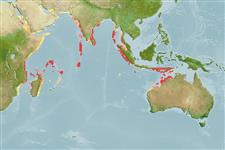Teleostei (teleosts) >
Gobiiformes (Gobies) >
Gobiidae (Gobies) > Gobiinae
Etymology: Eviota: No etymology given, suggested by Christopher Scharpt: from Latin 'eu' for 'true' and 'iota' for anything very small, in combination 'truly very small' referring to it as being the smallest vertebrate at the time it has benn described by Jenkins (thus, making the suggestion by Scharpt plausible.; mikiae: Named for Miki Tonzuka of Bali, Indonesia, for her assistance with fish collections during the Weh Islands survey (Ref. 44113).
Environment: milieu / climate zone / depth range / distribution range
Ecology
Marine; reef-associated; depth range 6 - 25 m (Ref. 30404). Tropical
Indian Ocean: Seychelles (Amirante Islands), Chagos Archipelago, Maldives, Thailand (Andaman Sea), and Indonesia (Sumatra).
Size / Weight / Age
Maturity: Lm ? range ? - ? cm
Max length : 3.5 cm TL male/unsexed; (Ref. 30404)
Dorsal spines (total): 7; Dorsal soft rays (total): 9; Anal spines: 1; Anal soft rays: 8. Pectoral fin rays simple; spinous dorsal fin moderately elongate in both sexes, second and third rays longest, fifth pelvic fin ray well developed, two-tenths to three-tenths length of fourth ray; cephalic sensory pore system lacking IT and PITO pores, and AITO pore single (except double in smallest paratype) and very small; posterior rays of second dorsal and anal fins elongate, forming a lanceolate shape; preserved specimens generally whitish with dark pigment along base of anal fin, extending along ventral edge of caudal peduncle; small dark spot usually present at lower caudal fin base; nostrils dark and pair of brown spots of variable intensity usually present on top of head, just behind eyes (Ref. 44113).
Inhabits rich coral reef slopes with moderate tidal currents, in small groups on large coral heads (Ref. 30404, 48637).
Life cycle and mating behavior
Maturities | Reproduction | Spawnings | Egg(s) | Fecundities | Larvae
Allen, G.R., 2001. Description of two new gobies (Eviota, Gobiidae) from Indonesian seas. aqua, J. Ichthyol. Aquat. Biol. 4(4):125-130. (Ref. 44113)
IUCN Red List Status (Ref. 130435)
Threat to humans
Harmless
Human uses
Tools
Special reports
Download XML
Internet sources
Estimates based on models
Preferred temperature (Ref.
123201): 27 - 29.3, mean 28.4 °C (based on 563 cells).
Phylogenetic diversity index (Ref.
82804): PD
50 = 0.5000 [Uniqueness, from 0.5 = low to 2.0 = high].
Bayesian length-weight: a=0.00708 (0.00333 - 0.01504), b=3.09 (2.92 - 3.26), in cm total length, based on LWR estimates for this (Sub)family-body shape (Ref.
93245).
Trophic level (Ref.
69278): 3.1 ±0.3 se; based on size and trophs of closest relatives
Resilience (Ref.
120179): High, minimum population doubling time less than 15 months (Preliminary K or Fecundity.).
Fishing Vulnerability (Ref.
59153): Low vulnerability (10 of 100).
Nutrients (Ref.
124155): Calcium = 335 [145, 854] mg/100g; Iron = 1.37 [0.62, 2.92] mg/100g; Protein = 17.7 [15.6, 19.5] %; Omega3 = 0.102 [0.038, 0.257] g/100g; Selenium = 31.5 [10.7, 85.1] μg/100g; VitaminA = 111 [24, 478] μg/100g; Zinc = 3.59 [2.08, 5.80] mg/100g (wet weight);
